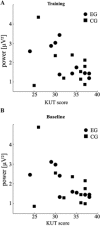Control beliefs can predict the ability to up-regulate sensorimotor rhythm during neurofeedback training
- PMID: 23966933
- PMCID: PMC3744034
- DOI: 10.3389/fnhum.2013.00478
Control beliefs can predict the ability to up-regulate sensorimotor rhythm during neurofeedback training
Abstract
Technological progress in computer science and neuroimaging has resulted in many approaches that aim to detect brain states and translate them to an external output. Studies from the field of brain-computer interfaces (BCI) and neurofeedback (NF) have validated the coupling between brain signals and computer devices; however a cognitive model of the processes involved remains elusive. Psychological parameters usually play a moderate role in predicting the performance of BCI and NF users. The concept of a locus of control, i.e., whether one's own action is determined by internal or external causes, may help to unravel inter-individual performance capacities. Here, we present data from 20 healthy participants who performed a feedback task based on EEG recordings of the sensorimotor rhythm (SMR). One group of 10 participants underwent 10 training sessions where the amplitude of the SMR was coupled to a vertical feedback bar. The other group of ten participants participated in the same task but relied on sham feedback. Our analysis revealed that a locus of control score focusing on control beliefs with regard to technology negatively correlated with the power of SMR. These preliminary results suggest that participants whose confidence in control over technical devices is high might consume additional cognitive resources. This higher effort in turn may interfere with brain states of relaxation as reflected in the SMR. As a consequence, one way to improve control over brain signals in NF paradigms may be to explicitly instruct users not to force mastery but instead to aim at a state of effortless relaxation.
Keywords: EEG; locus of control; neurofeedback; performance prediction; sensorimotor rhythm.
Figures



Comment in
-
Testing the Benefits of Neurofeedback on Selective Attention Measured Through Dichotic Listening.Appl Psychophysiol Biofeedback. 2016 Jun;41(2):157-64. doi: 10.1007/s10484-015-9323-8. Appl Psychophysiol Biofeedback. 2016. PMID: 26683198
References
-
- Beier G. (1999). Kontrollüberzeugungen im umgang mit technik. Report Psychologie 9, 684–693
-
- Beier G. (2004). Kontrollüberzeugungen im umgang mit technik: ein persönlichkeitsmerkmal mit relevanz für die gestaltung technischer systeme (Doctoral thesis). Available from GESIS database, Record No. 20040112708.
LinkOut - more resources
Full Text Sources
Other Literature Sources
Research Materials

